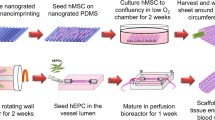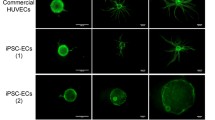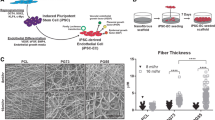Abstract
The development of stable, functional microvessels remains an important obstacle to overcome for tissue engineered organs and treatment of ischemia. Endothelial progenitor cells (EPCs) are a promising cell source for vascular tissue engineering as they are readily obtainable and carry the potential to differentiate towards all endothelial phenotypes. The aim of this study was to investigate the ability of human umbilical cord blood-derived EPCs to form vessel-like structures within a tissue engineering scaffold material, a cell-adhesive and proteolytically degradable polyethylene glycol hydrogel. EPCs in co-culture with angiogenic mural cells were encapsulated in hydrogel scaffolds by mixing with polymeric precursors and using a mild photocrosslinking process to form hydrogels with homogeneously dispersed cells. EPCs formed 3D microvessels networks that were stable for at least 30 days in culture, without the need for supplemental angiogenic growth factors. These 3D EPC microvessels displayed aspects of physiological microvasculature with lumen formation, expression of endothelial cell proteins (connexin 32, VE-cadherin, eNOS), basement membrane formation with collagen IV and laminin, perivascular investment of PDGFR-β and α-SMA positive cells, and EPC quiescence (<1% proliferating cells) by 2 weeks of co-culture. Our findings demonstrate the development of a novel, reductionist system that is well-defined and reproducible for studying progenitor cell-driven microvessel formation.






Similar content being viewed by others
References
Abdallah, B. M., M. Haack-Sørensen, J. S. Burns, B. Elsnab, F. Jakob, P. Hokland, and M. Kassem. Maintenance of differentiation potential of human bone marrow mesenchymal stem cells immortalized by human telomerase reverse transcriptase gene despite [corrected] extensive proliferation. Biochem. Biophys. Res. Commun. 326:527–538, 2005.
Adams, R. H., and K. Alitalo. Molecular regulation of angiogenesis and lymphangiogenesis. Nat. Rev. Mol. Cell Biol. 8:464–478, 2007.
Anagnostakis, I., A. C. Papassavas, E. Michalopoulos, T. Chatzistamatiou, S. Andriopoulou, A. Tsakris, and C. Stavropoulos-Giokas. Successful short-term cryopreservation of volume-reduced cord blood units in a cryogenic mechanical freezer: effects on cell recovery, viability, and clonogenic potential. Transfusion 54:211–223, 2014.
Armulik, A., G. Genové, and C. Betsholtz. Pericytes: developmental, physiological, and pathological perspectives, problems, and promises. Dev. Cell 21:193–215, 2011.
Bahney, C. S., T. J. Lujan, C. W. Hsu, M. Bottlang, J. L. West, and B. Johnstone. Visible light photoinitiation of mesenchymal stem cell-laden bioresponsibe hydrogels. Eur. Cell Mater. 22:43–55, 2011.
Belvisi, L., T. Riccioni, M. Marcellini, L. Vesci, I. Chiarucci, D. Efrati, D. Potenza, C. Scolastico, L. Manzoni, K. Lombardo, M. A. Stasi, A. Orlandi, A. Ciucci, B. Nico, D. Ribatti, G. Giannini, M. Presta, P. Carminati, and C. Pisano. Biological and molecular properties of a new alpha(v)beta3/alpha(v)beta5 integrin antagonist. Mol. Cancer Ther. 4:1670–1680, 2005.
Bompais, H., J. Chagraoui, X. Canron, M. Crisan, X. H. Liu, A. Anjo, C. Tolla-Le Port, M. Leboeuf, P. Charbord, A. Bikfalvi, and G. Uzan. Human endothelial cells derived from circulating progenitors display specific functional properties compared with mature vessel wall endothelial cells. Blood 103:2577–2584, 2004.
Carmeliet, P. Angiogenesis in life, disease, and medicine. Nature 438:932–936, 2005.
Chen, X., A. S. Aledia, C. M. Ghajar, C. K. Griffith, A. J. Putnam, C. C. Hughes, and S. C. George. Prevascularization of a fibrin-based tissue construct accelerates the formation of functional anastomosis with host vasculature. Tissue Eng. A 15:1363–1371, 2009.
Chwalek, K., M. V. Tsurkan, U. Freudenberg, and C. Werner. Glycosaminoglycan-based hydrogels to modulate heterocellular communication in in vitro angiogenesis models. Sci. Rep. 4:4414, 2014.
Culver, J. C., J. C. Hoffman, R. A. Poché, J. H. Slater, J. L. West, and M. E. Dickinson. Three-dimensional biomimetic patterning in hydrogels to guide cellular organization. Adv. Mater. 24:2344–2348, 2012.
Dejana, E., F. Orsenigo, and M. G. Lampugnani. The role of adherens junctions and VE-cadherin in control of vascular permeability. J. Cell Sci. 121(Pt 13):2115–2122, 2008.
Eapen, M., J. P. Klein, A. Ruggeri, et al. Impact of allele-level HLA matching on outcomes after myeloablative single unit umbilical blood transplantation for hematologic malignancy. Blood 123:133–140, 2014.
Eming, S. A., and J. A. Hubbell. Extracellular matrix in angiogenesis: dynamic structures with translational potential. Exp. Dermatol. 20:605–613, 2011.
Evensen, L., D. R. Micklem, A. Blois, S. V. Berge, N. Aarsaether, A. Littlewood-Evans, J. Wood, and J. B. Lorens. Mural cell associated VEGF is required for organotypic vessel formation. PLoS ONE 4:e5798, 2009.
Fang, J. S., C. Dai, D. T. Kurjiaka, J. M. Burt, and K. K. Hirschi. Connexin45 regulates endothelial-induced mesenchymal cell differentiation toward a mural cell phenotype. Arterioscler. Thromb. Vasc. Biol. 33:362–368, 2013.
Gill, B. J., D. L. Gibbons, L. C. Roudsari, J. E. Saik, Z. H. Rizvi, J. D. Roybal, J. M. Kurie, and J. L. West. A synthetic matrix with independently tunable biochemistry and mechanical properties to study epithelial morphogenesis and EMT in a lung adenocarcinoma model. Cancer Res. 72:6013–6023, 2012.
Hahn, M. S., L. J. Tate, J. J. Moon, M. C. Rowland, K. A. Ruffino, and J. L. West. Photolithographic patterning of polyethylene glycol hydrogels. Biomaterials 27:2519–2524, 2006.
Hanjaya-Putra, D., V. Bose, Y. I. Shen, J. Yee, S. Khetan, K. Fox-Talbot, C. Steenbergen, J. A. Burdick, and S. Gerecht. Controlled activation of morphogenesis to generate a functional human microvasculature in a synthetic matrix. Blood 118:804–815, 2011.
Haug, V., N. Torio-Padron, G. B. Stark, G. Finkenzeller, and S. Strassburg. Comparison between endothelial progenitor cells and human umbilical vein endothelial cells on neovascularization in an adipogenesis mouse model. Microvasc. Res. 97:159–166, 2015.
Herbert, S. P., and D. Y. Stainier. Molecular control of endothelial cell behavior during blood vessel morphogenesis. Nat. Rev. Mol. Cell Biol. 12:551–564, 2011.
Hirschi, K. K., J. M. Burt, K. D. Hirschi, and C. Dai. Gap junction communication mediates transforming growth factor-beta activation and endothelial-induced mural cell differentiation. Circ. Res. 93:429–437, 2003.
Hirschi, K. K., S. A. Rohovsky, L. H. Beck, S. R. Smith, and P. A. D’Amore. Endothelial cells modulate the proliferation of mural cell precursors via platelet-derived growth factor-BB and heterotypic cell contact. Circ. Res. 84:298–305, 1999.
Hotchkiss, K. A., A. W. Ashton, R. Mahmood, R. G. Russell, J. A. Sparano, and E. L. Schwartz. Inhibition of endothelial cell function in vitro and angiogenesis in vivo by docetaxel (Taxotere): association with impaired repositioning of the microtubule organizing center. Mol. Cancer Ther. 1:1191–1200, 2002.
Hynes, R. O. Cell–matrix adhesion in vascular development. J. Thromb. Haemost. 5(Supplement 1):32–40, 2007.
Ingram, D. A., L. E. Mead, H. Tanaka, V. Meade, A. Fenoglio, K. Mortell, K. Pollok, M. J. Ferkowicz, D. Gilley, and M. C. Yoder. Identification of a novel hierarchy of endothelial progenitor cells using human peripheral and umbilical cord blood. Blood 104:2752–2760, 2004.
Jain, R. K. Molecular regulation of vessel maturation. Nat. Med. 9:685–693, 2003.
Kawabe, J., and N. Hasebe. Role of the vasa vasorum and vascular resident stem cells in atherosclerosis. Biomed. Res. Int. 2014. doi:10.1155/2014/701571.
Kirkpatrick, C. J., S. Fuchs, and R. E. Unger. Co-culture systems for vascularization—learning from nature. Adv. Drug Deliv. Rev. 63:291–299, 2011.
Koehler, K. C., D. L. Alge, K. S. Anseth, and C. N. Bowman. A Diels–Alder modulated approach to control and sustain the release of dexamethasone and induce osteogenic differentiation of human mesenchymal stem cells. Biomaterials 34:4150–4158, 2013.
Korff, T., S. Kimmina, G. Martiny-Baron, and H. G. August. Blood vessel maturation in a 3-dimensional spheroidal co-culture model: direct contact with smooth muscle cells regulates endothelial cell quiescence and abrogates VEGF responsiveness. FASEB J 15:447–457, 2001.
Kut, C., F. Mac Gabhann, and A. S. Popel. Where is VEGF in the body? A meta-analysis of VEGF distribution in cancer. Br. J. Cancer 97:978–985, 2007.
Leong, M. F., J. K. Toh, C. Du, K. Narayanan, H. F. Lu, T. C. Lim, A. C. Wan, and J. Y. Ying. Patterned prevascularised tissue constructs by assembly of polyelectrolyte hydrogel fibres. Nat. Commun. 4:2353, 2013.
Lutolf, M. P., J. L. Lauer-Fields, H. G. Schmoekel, A. T. Metters, F. E. Weber, G. B. Fields, and J. A. Hubbell. Synthetic matrix metalloproteinase-sensitive hydrogels for the conduction of tissue regeneration: engineering cell-invasion characteristics. Proc. Natl. Acad. Sci. USA 100:5413–5418, 2003.
Marturano, J. E., J. D. Arena, Z. A. Schiller, I. Georgakoudi, and C. K. Kuo. Characterization of mechanical and biochemical properties of develo** embryonic tendon. Proc. Natl. Acad. Sci. USA 110:6370–6375, 2013.
Melero-Martin, J. M., Z. A. Khan, A. Picard, X. Wu, S. Paruchuri, and J. Bischoff. In vivo vasculogenic potential of human blood-derived endothelial progenitor cells. Blood 109:4761–4768, 2007.
Minuth, W. W., R. Strehl, and K. Schumacher. Tissue Engineering. Essentials for Daily Laboratory Work. Weinheim: Wiley-VCH Verlag, 2005.
Moon, J. J., J. E. Saik, R. A. Poche, J. E. Leslie-Barbick, S. Lee, A. A. Smith, M. E. Dickinson, and J. L. West. Biomimetic hydrogels with pro-angiogenic properties. Biomaterials 31:3840–3847, 2010.
Morais, J. M., F. Papadimitrakopoulos, and D. J. Burgess. Biomaterials/tissue interactions: possible solutions to overcome foreign body response. AAPS J. 12:188–196, 2010.
Nagase, H., and G. B. Fields. Human matrix metalloproteinase specificity studies using collagen sequence-based synthetic peptides. Biopolymers 40:399–416, 1996.
Novosel, E. C., C. Kleinhans, and P. J. Kluger. Vascularization is the key challenge in tissue engineering. Adv. Drug Deliv. Rev. 63:300–311, 2011.
Okamoto, T., N. Akita, E. Kawamoto, T. Hayashi, K. Suzuki, and M. Shimaoka. Endothelial connexin32 enhances angiogenesis by positively regulating tube formation and cell migration. Exp. Cell Res. 321:133–141, 2014.
Okamoto, T., M. Akiyama, M. Takeda, E. C. Gabazza, T. Hayashi, and K. Suzuki. Connexin32 is expressed in vascular endothelial cells and participates in gap-junction intercellular communication. Biochem. Biophys. Res. Commun. 382:264–268, 2009.
Peters, E. B., N. Christoforou, K. W. Leong, and G. A. Truskey. Comparison of mixed and lamellar co-culture spatial arrangements for tissue engineering capillary networks in vitro. Tissue Eng. A 19:697–706, 2013.
Peters, E. B., N. Christoforou, E. Moore, J. L. West, and G. A. Truskey. CD45+ cells present within mesenchymal stem cell populations affect network formation of blood-derived endothelial outgrowth cells. Biores. Open Access 4(1):75–88, 2015. doi:10.1089/biores.2014.0029.
Peters, E. B., B. Liu, N. Christoforou, J. L. West, and G. A. Truskey. Umbilical cord blood-derived mononuclear cells exhibit pericyte-like phenotype and support network formation of endothelial progenitor cells in vitro. Ann. Biomed. Eng. 2015. doi:10.1007/s10439-015-1301-z.
Phelps, E. A., N. Landázuri, P. M. Thulé, W. R. Taylor, and A. J. García. Bioartificial matrices for therapeutic vascularization. Proc. Natl. Acad. Sci. USA 107:3323–3328, 2010.
Potente, M., H. Gerhardt, and P. Carmeliet. Basic and therapeutic aspects of angiogenesis. Cell 146:873–887, 2011.
Rao, R. R., A. W. Peterson, J. Ceccarelli, A. J. Putnam, and J. P. Stegemann. Matrix composition regulates three-dimensional network formation by endothelial cells and mesenchymal stem cells in collagen/fibrin materials. Angiogenesis 15:253–264, 2012.
Rouwkema, J., N. C. Rivron, and C. A. van Blitterswijk. Vascularization in tissue engineering. Trends Biotechnol. 26:434–441, 2008.
Saik, J. E., D. J. Gould, A. H. Keswani, M. E. Dickinson, and J. L. West. Biomimetic hydrogels with immobilized ephrinA1 for therapeutic angiogenesis. Biomacromolecules 12:2715–2722, 2011.
Seeto, W. J., Y. Tian, and E. A. Lipke. Peptide-grafted poly(ethylene glycol) hydrogels support dynamic adhesion of endothelial progenitor cells. Acta Biomater. 9:8279–8289, 2013.
Sekine, H., T. Shimizu, K. Hobo, S. Sekiya, J. Yang, M. Yamato, H. Kurosawa, E. Kobayashi, and T. Okano. Endothelial cell co-culture within tissue-engineered cardiomyocyte sheets enhances neovascularization and improves cardiac function of ischemic hearts. Circulation 118:S145–S152, 2008.
Senger, D. R. Molecular framework for angiogenesis: a complex web of interactions between extravasated plasma proteins and endothelial cell proteins induced by angiogenic cytokines. Am. J. Pathol. 149:1–7, 1996.
Senger, D. R., and G. E. Davis. Angiogenesis. Cold Spring Harb. Perspect. Biol. 3:a005090, 2011.
Stupack, D. G., and D. A. Cheresh. Integrins and angiogenesis. Curr. Top. Dev. Biol. 64:207–238, 2004.
Tremblay, P. L., V. Hudon, F. Berthod, L. Germain, and F. A. Auger. Inosculation of tissue-engineered capillaries with the host’s vasculature in a reconstructed skin transplanted on mice. Am. J. Transplant. 5:1002–1010, 2005.
Turturro, M. V., M. C. Christenson, J. C. Larson, D. A. Young, E. M. Brey, and G. Papavasiliou. MMP-sensitive PEG diacrylate hydrogels with spatial variations in matrix properties stimulate directional vascular sprout formation. PLoS 8:e58897, 2013.
Tziros, C., and J. E. Freedman. The many antithrombotic actions of nitric oxide. Curr. Drug Targets 7:1243–1251, 2006.
Unger, R. E., S. Ghanaati, C. Orth, A. Sartoris, M. Barbeck, S. Halstenberg, A. Motta, C. Migliaresi, and C. J. Kirkpatrick. The rapid anastomosis between prevascularized networks on silk fibroin scaffolds generated in vitro with co-cultures of human microvascular endothelial and osteoblast cells and the host vasculature. Biomaterials 31:6959–6967, 2010.
Vigen, M., J. Ceccareli, and A. J. Putnam. Protease-sensitive PEG hydrogels regulate vascularization in vitro and in vivo. Macromol. Biosci. 14:1368–1379, 2014.
Welti, J., S. Loges, S. Dimmeler, and P. Carmeliet. Recent molecular discoveries in angiogenesis and antiangiognic therapies in cancer. J. Clin. Invest. 123:3190–3200, 2013.
Wu, X., E. Rabkin-Aikawa, K. J. Guleserian, T. E. Perry, Y. Masuda, F. W. Sutherland, F. J. Schoen, J. E. Mayer, Jr, and J. Bischoff. Tissue-engineered microvessels on three-dimensional biodegradable scaffolds using human endothelial progenitor cells. Am. J. Physiol. Heart Circ. Physiol. 287:H480–H487, 2004.
Yang, J., U. Nagavarapu, K. Relloma, M. D. Sjaastad, W. C. Moss, A. Passaniti, and G. S. Herron. Telomerized human microvasculature is functional in vivo. Nat. Biotechnol. 19:219–224, 2001.
Yoder, M. C. Human endothelial progenitor cells. Cold Spring Harb Perspect Med. 2:a006692, 2012.
Yoder, M. C. Endothelial progenitor cell: a blood cell by many other names may serve similar functions. J. Mol. Med. (Berl). 91:285–295, 2013.
Yoder, M. C., L. E. Mead, D. Prater, T. R. Krier, K. N. Mroueh, F. Li, R. Krasich, C. J. Temm, J. T. Prchal, and D. A. Ingram. Redefining endothelial progenitor cells via clonal analysis and hematopoietic stem/progenitor cell principals. Blood 109:1801–1809, 2007.
Acknowledgments
This study was supported by NIH Grant 5R01HL097520 and NSF Graduate Research Fellowship 1106401 to E.B.P. The authors would like to acknowledge Ms. Yan Wu for her assistance in mechanical testing.
Conflicts of interest
Erica B. Peters, Nicolas Christoforou, Kam W. Leong, George A. Truskey, and Jennifer L. West declare that they have no conflicts of interest.
Ethical Standards
No human or animal studies were carried out by the authors of this article.
Author information
Authors and Affiliations
Corresponding author
Additional information
Associate Editor Michael R. King oversaw the review of this article.
Electronic Supplementary Material
Below is the link to the electronic supplementary material.
Supplemental Fig. 1
Representative histograms from flow cytometry characterization of EPCs at passage 3 showing expression for EC-associated marker expression for CD31, CD105, CD309/VEGFR2, CD146, and CD34 (A) and lack of expression for leukocyte-associated markers CD115 and CD45 and mesenchymal stem cell/fibroblast-associated marker CD90 (B). The y-axis is the percentage of the maximum number of events within the FITC or PE channel, the x-axis indicates the relative fluorescence intensity of PE or FITC expression, calculated by integration of fluorescence over the cell area. The percentage of positive cells for each condition is in reference to the negative control, which consisted of mouse IgG1 isotype, indicated by a red outline. A minimum of 9000 events were analyzed per condition (TIFF 3249 kb)
Supplemental Fig. 2
Characterization of SMCs for mural cell-associated protein markers α-SMA, calponin, PDGFR-β, and Ephrin-B2. Scale bar equals 100 µm (TIFF 10067 kb)
Supplemental Fig. 3
(A) Representative images of microvessel formation throughout the hydrogel by GFP-transduced HUVECs and hCB-EPCs (EPCs) in 1:1 co-culture with SMCs (not visible) after 14 days of culture. Scale bar equals 50 µm. (B) Representative images of hCB-EPC (EPC) monoculture controls at days 7 and 14 after encapsulation. Images were taken within a 50-µm depth from the gel surface. Scale bar equals 250 µm. (C) Representative images depicting the localization of SMCs, transduced with GFP, near microvessels formed by hCB-EPCs (EPCs) or HUVECs, transduced with tomato-fluorescent protein, after 14 days of culture. Images were taken within a 50-µm depth from the gel surface. Scale bar equals 250 µm. (D) Representative image of EPC microvessels, transduced with GFP, after 30 days of in vitro co-culture with SMCs (not visible) at a 1:1 ratio. Images were taken within a 50-µm depth from the gel surface. Scale bar equals 250 µm (TIFF 16793 kb)
Rights and permissions
About this article
Cite this article
Peters, E.B., Christoforou, N., Leong, K.W. et al. Poly(Ethylene Glycol) Hydrogel Scaffolds Containing Cell-Adhesive and Protease-Sensitive Peptides Support Microvessel Formation by Endothelial Progenitor Cells. Cel. Mol. Bioeng. 9, 38–54 (2016). https://doi.org/10.1007/s12195-015-0423-6
Received:
Accepted:
Published:
Issue Date:
DOI: https://doi.org/10.1007/s12195-015-0423-6




